
I am happy to present the next article in the Cultural Corner series by my colleague Christian Noni. He has a great love and respect for ancient culture and its attending rituals. He is also a collector of ancient jewelry and artifacts relating to body modification. Christian has undergone some serious surgical modifications to his mouth and has documented them for us here in his own words.
In a related note, the Museum of Man in San Diego is completing the hosting of a body modification special exhibit which runs through March. Art from San Diego's piercing studio, Church of Steel, is primarily responsible for putting it together. I have known Art for some fifteen years, and know of his great love of tribal culture. Along with photos of many familiars in the piercing industry, there is a small but relevant display of jewelry. Art has my respects for orchestrating this exhibit and helping to educate not just piercers, but the public in general.
With modified people no longer considered a "fringe" culture, many large museums are following suit, and presenting similar exhibitions. For those modified individuals in and outside of the industry, I highly recommend visiting the museum if you are in Southern California. You might even score a copy of my book, A Brief History of the Evolution of Body Adornment in Western Culture, at the museum's gift shop. The limited edition body mod book is nearly sold out. Also check out my new DVD for you hardcore traditional bodymod fans.
- Blake
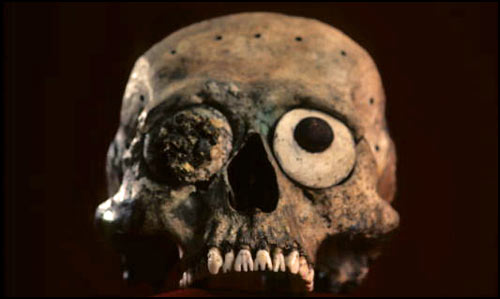
Semi-Precious Teeth
"To embrace our future, we must first embody our past."
- Christian Noni
As a professional piercer, I have always been interested in the historical aspects of body modification. Since I was nearly ten years old, I have collected ethnographic pieces. Anything from traditional Native American dream catchers and weapons, to my mid teens collecting antique piercing jewelry. I feel it is essential to not only respect what tribal cultures around the world created but to also embody it. Thus, I felt using the word "embody" would be the perfect name for the piercing studio that I am opening up. My studio not only performs traditional body piercing and tattooing, but we also plan to have a mini museum of ancient tribal artifacts, primarly focusing on ancient body piercing jewelry and other forms of ritualistic objects. We encourage all people from all walks of life to come and visit us.
From the beginnings of human culture as well as in the present, body modification has served its purpose in our bodies through many different aspects. Aside from common body piercing and tattooing, we as modern beings practise the beauty of adornment through in many other ways — cosmetic surgery, wearing make up, weight lifting, and so on. One large form of body modification with a beautiful history is tooth modifications. In this modern age in body modification, it may be interesting to look back at what the Mayans did in particular.
With a highly developed culture, the Mayans were peaceful people who inhabited the Yucatan Peninsula as well as present-day Guatemala and Honduras. The nation's history began about 2500 B.C. and the culture flourished from about 300 A.D. to about 900 A.D. They were accomplished smelters and forgers of gold, silver, and bronze, in addition to being highly skilled in cutting, polishing, and engraving semi-precious stones. Many of these skills can be seen in Pre-Columbian earrings, necklaces, and masks.
One form of Mayan stonework that was widely popular was inlaying polished stones into teeth. The Mayans were skilled in the fabrication and placement of beautifully carved stone inlays in precisely prepared cavities in the front teeth. These inlays were made of various minerals, including jadeite, iron pyrites, hematite, turquoise, quartz, opal, serpentine, and cinnabar. The purpose of enhancing teeth blossomed for ritual or religious purposes — some believed that inserting gems into their teeth and filing them in elaborate designs would enhance the voice spiritually, thus resulting in direct communication with God(s).
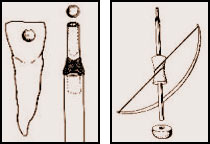
The tools illustrated above are examples of what kind of tools the Mayans may have used for gem inlaying. Illustrations courtesy of Dr. Schilling.
A round, hard tube was spun between the hands, or in a rope drill, with a slurry of powdered quartz in water as an abrasive, to cut a perfectly round hole through the tooth enamel. The stone inlay was ground to fit the cavity so precisely that many have remained in the teeth for thousands of years. Human skull remains can still be seen in museums today with gems still intact in the tooth.
Not only did the Mayans insert beautiful stones into their teeth, but they too also decorated their teeth in other ways. Some forms of tooth adornment that they performed included carving their teeth in various shapes (which you can see above and in the skull at the top of the article). One of the most extroardinary forms of tooth adornment were their inventive techniques in replacing teeth. Modern oral surgeons now have only just scratched the surface of what was commonly practised over two thousand years ago. Replacing their own teeth with those from animals (and other humans) as well as shells and other implants — not only was this form of adornment was widely practiced but was greatly achieved, with archaelogical evidence that the human bone anatomically bonded to the implants and healed.
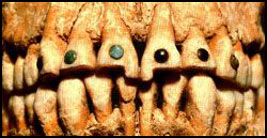
The teeth of this Mayan skull of the ninth century A.D. have numerous inlays of jade and turquoise. Also note how the upper front teeth have been filed, particularly the decorative front two teeth. Photo courtesy of Dr. Schilling.
Personally growing up with crooked teeth, I had spent more than half of my life trying to achieve that "perfect smile", undergoing through my youth having braces, headgear, permanent retainers, and temporary retainers. After somewhat achieving that nice smile in my early teens, I assumed the ongoing procedures were coming to an end. Without knowing what the future held in store for me, I ended up finding that I had a rare disease. My father and my uncle have it as well, and I got it early — because of this, I had to undergo more extreme procedures to save my teeth. I underwent numerous tooth extractions, over twenty-five root canals, and lastly dental implants. Dr. Downey quoted that I "have literally gone through more dental work in the last five years than roughly thirty people added up would in their entire lifetime". All in the name of beauty... After going through well over five years of procedures in trying to achieve that perfect smile, I became very attentive towards other peoples smiles, and with that, I became even more self-conscious of my smile. I already got enough attention for my modifications, and I was receiving even more attention with my ugly smile. Over time I trained myself to smile in a certain way where my bad teeth were not as visible. People typically don't realize how much a person's smile can make all of the difference in the world. My smile was affecting my job, dating, and even making friends.
Since I was having all of my teeth fixed, I wanted to add a spice of historical traditional adornment to my teeth. I had always been fascinated by what the Mayans did to their teeth, and as time went by, I felt it was time to embody what our neighboring culture created. My friend and dentist, Dr. Downey, was well aware of the historical culture of Mayan dentistry. As open-minded as he is, he was more than happy to help me achieve this ancient form of beauty. Typically his clientel would insert diamonds or rubies in their teeth, so he was experienced in the procedure. However, I wanted my teeth to be as beautiful and traditional as the Mayans did. Thus, I made plans to have solid opal gems inlayed into my upper and lower canine teeth.
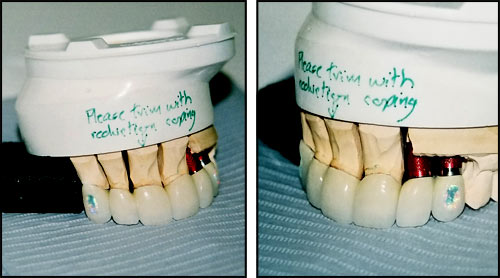
The procedure was not as simple as the one the Mayans used. Considering my teeth are porcelain, the procedure required more delicate techniques when inlaying the stones. Despite the beautiful appearance opal stones have, it is a naturally formed crystal glass. Thus, major preparations were involved to make sure the stones would be inlayed correctly and appear beautiful, and also last for years to come as well. Preparing the teeth and gems took much longer than than actually insert them. The upper and lower canines were prepped in a lab, then hollowed out. On the front of the tooth was a hole for where the gem would be inserted and be visible. The gems were actually not inlayed from the front as most people would assume. They were inlayed from the inside of the new tooth, then supported from behind with porcelain. This is to prevent the opal stone from falling out from the front. Thus, the gem is encased entirely in porcelain with a clear epoxy encased on the front of the gem for extra support (click for a closeup). Once my new gem teeth were ready for insertion, a localized anesthesia was injected. Dr. Downey removed my upper and lower temporary canines and prepped the surrounding gums for my new canines. A dental instrument silimar to a surgical elevator instrument was used to push down on the gums to make room. Once that was achieved, the new tooth was prepped and inserted with a cement epoxy agent to bond permanently. The actual procedure took no more than ten minutes per canine set. Both Dr. Downey and myself were very pleased with the results of how everything looked.
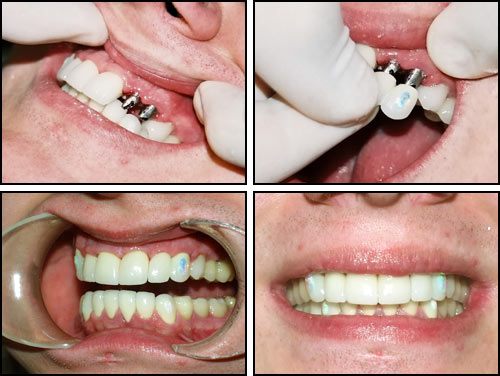
Dr. Downey has not only changed my life with my great new smile, but he too has brought me a step closer to the essence of body adornment. For that, words can not express my gratitude on how thankful I am to have him not only as my dentist, but as a friend who I will never forget.
For more information, you may contact me directly at [email protected]. If you would like to contact Dr. Downey, please go to www.RalphDowneyDDS.com for more information.
Click here to comment on or discuss this article